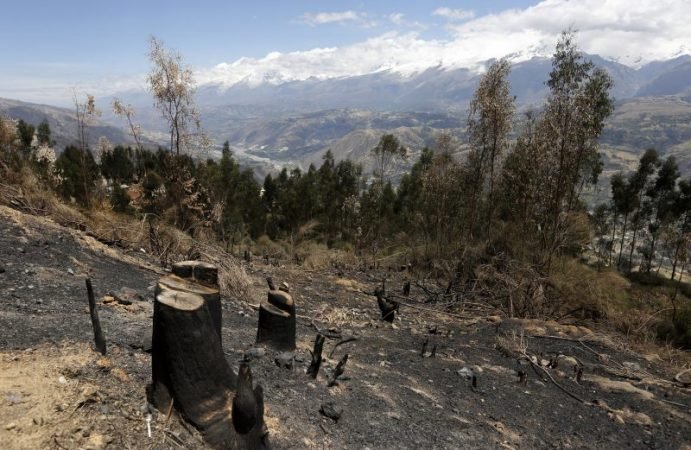Climate Change and Regional Implications in the context of Latin America

The UNFCC defines climate change as “a change in climate which is attributed directly to human activity that alters the composition of the global atmosphere and which is in adoption to natural climate variability observed over a comparable time period”. We have been hearing how climate change will impact the future of humankind for quite a long time. But we often didn’t realize the fact that climate change is not our tomorrow but it’s a reality of our today. Perhaps, we conveniently ignore the effects of changing climate and continue to believe that tomorrow everything will be back to normal. However, there are certain incidents, such as the wildfires Amazon forest, Australian wildfires, the sinking of Pacific Ocean islands of Tuvalu and Vanuatu, the frequent floods and droughts all over the world, that remind us we cannot live being oblivious about the greatest danger looming over the human race.
The Latin American region has been impacted by the shifting patterns of ecosystems, climatic fluctuations and varying land use that eventually led to the continent’s rising sea levels and constant floods and droughts. According to a United Nations report, the freshwater sources in the Latin American continent has been running out and the regions “a third of the population does not have access to drinking water. Earlier, the governments and citizens were of the view that the scarcity of water was due to Multinational Corporation’s exploitation of water resources as in the case of Bolivia, but they are slowly realizing that the real villain is in fact; climate change.
El Nino and the Peruvian Economy
A significant consequence of climate change in the region is the varying temperature and atmospheric air circulation. The changing air circulation has intensified the anticyclones in the region and the direction change of Jet streams influenced in magnifying the El Nino.

El Nino is a climatic phenomenon that occurs when the water in the eastern tropical Pacific becomes abnormally warm. This causes the drier places in the eastern coast of Pacific, particularly in Peruvian coast, experiences heavy rainfall and huge floods, whereas in the western coast of the Pacific, Indonesia and Australia, faces severe droughts and wildfires. In a normal situation, the warm water and the heavy downpour occurs in the western part of the Pacific and also influences the Indian monsoon pattern. The El Nino has been occurring in every 2-3 years causing devastating consequences in the social and economic lives of people in both sides of the Pacific. Even though the real reason behind the El Nino is still unknown it is highly attributed to the changing atmospheric air circulation which then influences the ocean currents in the Pacific Ocean.
As said earlier the aftermath of the El Nino causes serious damage to the lives and livelihood of people across the globe especially Peru struggle the most economic and social wise in the Latin American continent. The fisheries sector is a foremost important economic sector for the country since the industry is a significant source for foreign currency to the country. In 2008 according to the FAO, the Peruvian fish market exported a record of 19 percent more volume than in 2007. Even though the fisheries sector contributes to the 0.5 to 0.6 percent of the GDP, the economic activity created by the industry contributes to 0.8 to 1.4 percent of GDP. The strongest ever recorded El Nino in 1997- 1998 period witnessed the largest damage the country has faced. The heavy and unexpected rainfall due to the El Nino caused the rise in water levels in rivers and dams which eventually led to flash floods taking lives’ of thousands of people. The floodwater caused the ‘Sechura Desert’, that was dry for a long time, become the second largest lake in Peru.
The warming of water near the coast of Peru has the greatest impact on the fisheries industry. The slightly warming up of the waters has decreased the volume of cold water Anchovy’s, a major fish catch from Peru, to drop significantly. The cold water Anchovies are used in animal feeding and Peru is the major exporter of the fish. Due to the low amount of fish export from the country, it had experienced an economic slowdown in 2016.

Amazon Wildfires
According to the Brazilian Space Agency known as INPE, there were 74, 155 wildfires, releasing tons of carbon dioxide into the atmosphere, in the Brazilian Amazon since the start of 2019. The scientific community fears that this may trigger the increase in global warming, not only in Brazil but also in the whole world. Amazon rain forest, also known as the lungs of the planet is the largest forest survived till present day in the globe. The forest is home for rare and nearly extinguishing plant and animal species. Being the largest forest complex, the Amazon plays a major role as the carbon sink of our ecosystem. According to the interview with Prof. Nobre, a leading expert on the Amazon, from a BBC report “the Amazon forests in the 1980s and 1990s used to absorb 2 billion tonnes of Carbon dioxide from the atmosphere whereas at present the capacity has reduced to 1- 1.2 tonnes per year”.

According to researchers, the main reason behind frequent occurring of recent wildfires in the Amazon is the deforestation activities in the forest for agriculture expansion and pasture industry. The trade war between America and China has also influence in increasing deforestation for the production of soya bean crops. The increased rate of meat consumption around the world speeds up the deforestation process for making space for ranches in Brazil. Based on the study of Amazon Conservation’s, Monitoring of the Andean Amazon project, the 2019 wildfires had burned 52,500 ha of forest land and it’s still continuing. The deforestation activities followed by the intense fire for preparing agriculture land often spreads to the surrounding forests thereby erupting wildfires. The Amazon range is too humid to have frequent self-sustained wildfires. Most of the time it is the human activity which causes the damage to the forest.
The policies of changing governments also influence the conservation of biodiversity and the ecosystem of a country. The Brazilian government in 2004 took measures for the conservation of the Amazon forest by implementing strict policy methods and punishments to punish the perpetrators of deforestation. The government allowed protected areas for the indigenous community. However, since Jair Bolsonaro came into power the situation has changed. The far-right leader, Bolsonaro, with his promise to boost the economy, has been indirectly supporting the clearing of forest for increasing agriculture activities. He was also involved in rallying against the protection of indigenous communities, according to Los Angeles time’s news report. The domestic politics plays a great role in the protection of Amazon forest and the current Brazilian politicians need to evaluate their policies regarding environmental protection.
Latin America responding to climate change
The threat of climate change affects all the aspects of the daily life of the modern world. In this critical scenario, coordinated efforts from the countries in the region are absolutely necessary. Along with nations international organizations also play a key role in mitigating climate-induced havocs.
The 1992 United Nations Convention on Environmental and Development convention in Rio De Janeiro had witnessed the world’s first-ever climate change tackling initiative – the UNFCC. The Rio de Janeiro convention also known as the Earth summit, initiated the intergovernmental initiative for addressing the global warming and greenhouse gas emissions. The Latin American countries are involved in this intergovernmental and inter-organization initiative.

In the regional level, there are several intergovernmental organizations to coordinate the Latin American climate change mitigation programs. The Latin American Parliament and Latin American Energy Organization (OLADE) are the two organizations which are in the front line to tackle the issues regarding climate change. The Latin American Parliament was institutionalized with a treaty in 1987. The organization is of a single chamber, with these bodies the Assembly; the Chief Executives Board; the Permanent Committees; and the Secretary-General. This Organization addresses the issues pertaining to climate change and tourism and also coordinates with UNEP to carryout regional communication program. The Latin American Energy Organization was formed in 1973 to achieve regional energy integration. This Organization also involves in activities to increase the use of renewable energy resources and sustainable energy practices.
The Union of South American Nations (UNASUR), is another regional organization in the Latin American region focusing on the climate change aspects. The organization initially consisted of 12 members but recently most of the members withdraw because of the worrying situation of Venezuela’s Nicolas Maduro. The Organization has a focused view on the issues of biodiversity and the ecosystem.
In summary, climate change has a significant impact on the Latin American region. The deforestation and increased land use for agricultural production has changed the topography of the South American continent. With devastating floods, droughts and wildfires the continent has been constantly experiencing the effects of changing climate. In this situation, effective strategies involving more intergovernmental and intragovernmental cooperation is needed. In the present scenario with internal conflicts among the countries in the continent, the coordination efforts are being unfruitful. However, we can hope that for the goodwill of humanity, the countries will find more common areas to deal with climate change and its effects.



















